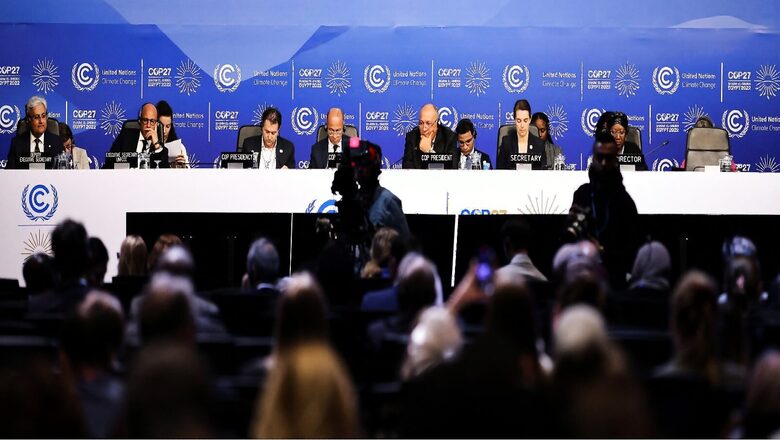
views
COP27 witnessed over 45,000 people exchanging knowledge, finding solutions, forming alliances and collaborating. The decisions made at COP27 reiterate the critical necessity of equipping all stakeholders i.e. governments, private sector, civil society and communities to promote more extensive and inclusive climate action at all levels. At COP27, young people in particular received more attention, with the UN Executive Secretary for Climate Change promising to press governments to not only hear the solutions put forth by young people, but also to take those solutions into account when making decisions and forming policies. Through the first-ever children and youth pavilion and the first-ever youth-led Climate Forum, young people made their voices heard.
The victory of the small and developing nations, which led to the creation of the Loss and Damage Fund, will be remembered as COP27’s most significant accomplishment. This demand has been fuelled by emerging markets like India, Brazil, and South Africa. The 20 countries that are most vulnerable to the effects of climate change, collectively known as the V20 group, mobilised successfully in this area. This group accounts for only 5 percent of all carbon emissions and has a population of 1.5 billion. The group was determined to make a final decision on the subject of loss and damage caused by developed countries because of this.
What makes loss and damage theory debatable?
The loss and damage theory states that the term ‘loss’ measures the harm that climate change has caused to infrastructure, such as buildings, ports, and roads. As opposed to this, the word ‘damage’ has been used to refer to the decrease in productivity brought on by climate change, including unexpected temperature increases, shortened workdays, declining agricultural productivity, and a decline in tourism. Additionally, it is thought that climate finance is distinct from the loss and damage budget (Loss and Damage Fund) established to compensate for disasters (Climate Fund).
It is not uncommon to request compensation for loss and damage. Since Vanuatu in the Pacific Ocean proposed a plan in 1991 for high-emitting nations to direct funds toward those affected by sea level rise, developing countries and small island states have been pressing for such funds. Rich countries are opposed to this type of fund because they fear that contributing to it will be interpreted as an admission of liability, leading to legal disputes. There has also been some confusion about its definition, specifically whether loss and damage constitute a form of liability, payment, or damages.
This concept, in some ways, represents the compensation sought by small, developing, and emerging economies in order to recover from the negative effects of climate change.
During the 2019 Madrid Climate Summit, a technical assessment programme for climate compensation was also developed. Currently, the United Nations and some development banks assist countries affected by climate change. According to a report, $580 billion will be needed by 2030 to adopt the loss and damage formula.
Equal women participation missing at COP27
In the 20 years since the first Conference of Parties (COP) was held, less than five women have held the position of COP President. Despite the precedent being set in the first COP under the presidency of former German Chancellor Angela Merkel, men still predominate in the rotating Presidency in every region. The relationship between gender and climate change was first acknowledged by the United Nations Framework Convention on Climate Change (UNFCCC) in 2001. A Gender Action Plan, as defined by the UNFCCC, focuses on five key areas that advance gender equity in climate-related issues. Due to the trend of underrating women’s needs in relation to climate change, there are fewer voices advocating for them. At the 28th Conference of Parties (COP28), women are now demanding more representation. As the host nation of COP28, the United Arab Emirates is being urged to elect a female president in response to calls from women for greater representation.
Sustainable Strategies presented by India at COP27
While the rich countries were busy twisting the final agreement to their advantage at COP27 in Egypt, India took a bold step by presenting its Long-Term Low Emission Development Strategy at the UNFCCC. In the midst of its ambitious development goals, India has demonstrated to the world its achievements and future commitments in the field of climate justice. India presented its newly launched and significant initiatives in renewable energy, e-mobility, ethanol-blended fuels and green hydrogen as an alternative energy source.
India’s approach is founded on four key considerations that serve as the foundation of its long-term low-carbon development strategy:
- Despite having 17 percent of the world’s population, India has contributed little to global warming, with its historical contribution to cumulative global GHG emissions being negligible
- India’s development requires a significant amount of energy
- India is committed to and is actively pursuing low-carbon development strategies in accordance with national circumstances
- India needs to strengthen its climate resilience
Furthermore, India stated at COP27 that it will promote future sustainable, climate and resilient development through its Smart Cities initiative. The country will meet its NDC (Nationally Determined Contribution) commitment of 2.5 to 3 billion tonnes of additional carbon sequestration by forest tree cover by 2030. India had updated its NDC even before the Egypt Climate Conference was held.
Due to the voluntary nature of NDCs, this will serve as a mirror to those countries that have forgotten their promise made in the Paris Agreement. The LiFE (Life for Environment) mission has been started by India some time ago in this series. The country has also demonstrated, by fulfilling its commitments, that any effort to save the Earth will only be realised through an eco-friendly lifestyle. Rich countries that promised to solve the climate crisis were exposed during the Russia-Ukraine War when they turned energy into a weapon. The main failure of the Egypt Climate Conference was the lack of specific progress in increasing economic cooperation for climate change solutions. The COP27 agreement also states that to achieve the goal of zero carbon emissions by 2030, a $4 trillion investment in renewable energy projects will be required.
Climate Finance Promises by Other Countries
The first nation to allocate $7.9 million for climate compensation is Scotland. Germany has promised 170 million, Ireland 10 million, Australia 50 million, Belgium 2.5 million, and Denmark 12 million dollars. The ignorance of nations with the highest per capita carbon emissions in the world, including the United States, Russia (the second-largest per capita emitter), the United Kingdom and the European Union, is surprising. They initially opposed the Loss and Damage Fund and since its establishment, they have been completely silent on climate finance. It raises concerns about the fund’s dependence on voluntary contributions alone, as well as when and how it will be used.
It was also unexpected how China responded in Sharm el-Sheikh. China, which has the third-highest per-capita carbon emissions in the world, is looking for funding to combat climate change. European countries disliked China’s response. Similar circumstances have been observed in countries like Venezuela and the Arab countries, which are the largest oil producers and earn significant profits from oil, but were considering using climate compensation as bailout money.
Thus, creating a compensation fund for climate loss and damage can provide small and developing countries with temporary relief. But, in order to find a lasting solution to the climate crisis, the world fraternity would have to focus on mitigating the effects of natural disasters rather than resolving their causes.
Conclusion
Any change is possible when there is political will, leadership and investment. The question is, if developed countries refuse to provide $100 billion per year to developing countries to assist them in transitioning to a climate-friendly economy, how serious will they be about providing technology and expertise for green initiatives? However, by outlining a long-term low-emission development strategy, India has not only made the world’s economic superpowers aware of their obligations but also communicated to developing nations that blaming developed nations won’t do anything to protect the environment and that everyone must take the necessary steps.
Key outcomes
A breakthrough agreement on the new Loss and Damage Fund at COP27 shows a ray of hope for progress. A dedicated fund and new funding arrangements were established by governments in a ground-breaking move to help developing nations respond to loss and damage. As part of their agreement, governments also decided to form a “transitional committee” that will advise them on how to operationalise the fund and the new funding arrangements at COP28 this year. The transitional committee’s inaugural meeting is anticipated before March 2023 comes to a close.
Other outcomes include:
- Promotion of climate technology solutions in developing nations through the launch of a new five-year work programme
- Countries launched 25 new collaborative actions in five key areas: power, road transportation, steel, hydrogen, and agriculture
- To urgently scale up mitigation ambition and implementation, a work programme on mitigation will begin immediately after COP27 and run until 2026.
- Plan to ensure early warning systems within the next five years
- Further, new pledges totalling over $230 million were made to the Adaptation Fund. Through concrete adaptation solutions, these pledges will assist many more vulnerable communities in adapting to climate change
The author is an environmental expert. Views expressed are personal.
Read all the Latest Opinions here




















Comments
0 comment